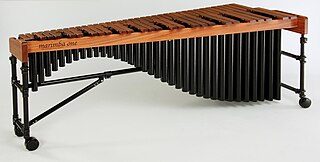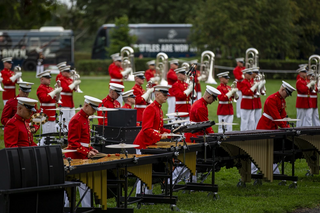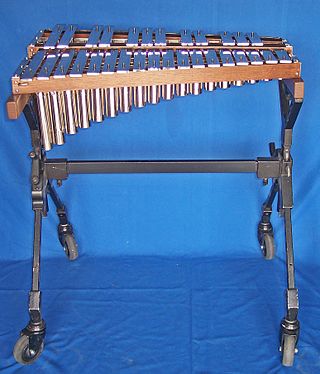
A percussion instrument is a musical instrument that is sounded by being struck or scraped by a beater including attached or enclosed beaters or rattles struck, scraped or rubbed by hand or struck against another similar instrument. Excluding zoomusicological instruments and the human voice, the percussion family is believed to include the oldest musical instruments.

The marimba is a musical instrument in the percussion family that consists of wooden bars that are struck by mallets. Below each bar is a resonator pipe that amplifies particular harmonics of its sound. Compared to the xylophone, the timbre of the marimba is warmer, deeper, more resonant, and more pure. It also tends to have a lower range than that of a xylophone. Typically, the bars of a marimba are arranged chromatically, like the keys of a piano. The marimba is a type of idiophone.

The vibraphone is a percussion instrument in the metallophone family. It consists of tuned metal bars and is typically played by using mallets to strike the bars. A person who plays the vibraphone is called a vibraphonist,vibraharpist, or vibist.

The glockenspiel or bells is a percussion instrument consisting of pitched aluminum or steel bars arranged in a keyboard layout. This makes the glockenspiel a type of metallophone, similar to the vibraphone.

Tubular bells (also known as chimes) are musical instruments in the percussion family. Their sound resembles that of church bells, carillon, or a bell tower; the original tubular bells were made to duplicate the sound of church bells within an ensemble. Each bell is a metal tube, 30–38 mm (1+1⁄4–1+1⁄2 in) in diameter, tuned by altering its length. Its standard range is C4–F5, though many professional instruments reach G5. Tubular bells are often replaced by studio chimes, which are a smaller and usually less expensive instrument. Studio chimes are similar in appearance to tubular bells, but each bell has a smaller diameter than the corresponding bell on tubular bells.

In a marching band, drum and bugle corps, or indoor percussion ensemble, the front ensemble or pit is the stationary percussion ensemble. This ensemble is typically placed in front of the football field, though some designers may use atypical layouts. Some high school marching bands opt not to march any percussion instruments but instead have a "full" front ensemble.
The marimbaphone is an obsolete tuned percussion instrument, developed by the J.C. Deagan Company of Chicago, Illinois, U.S. in the early 20th century.
The Verdin Company is a manufacturer of bronze bells, clocks and towers based in Cincinnati, Ohio in the United States. The company has been making bells for use in bell and clock towers, peals, chimes, and carillons since 1842. They also manufacture electronic carillons, street clocks, glockenspiels, and monuments. There is now an organ division serving churches and other institutions combining organ and bell music.
Clair Omar Musser (1901–1998) was a marimba virtuoso, a conductor and promoter of marimba orchestras, a composer, a teacher, a designer of keyboard percussion instruments, an inventor, and an engineer for Hughes Aircraft.
The Church of Saint Francis of Assisi and Saint Blaise is a Roman Catholic parish church in the Roman Catholic Diocese of Brooklyn, located at Nostrand Avenue and Lincoln Road, in Prospect Lefferts Gardens, Brooklyn, New York City, New York 11225.

A keyboard percussion instrument, also known as a bar or mallet percussion instrument, is a pitched percussion instrument arranged in a similar pattern to a piano keyboard and played with hands or percussion mallets. While most keyboard percussion instruments are fully chromatic, keyboard instruments for children, such as ones used in the Orff Schulwerk, may be diatonic or pentatonic.
This is a partitioned list of percussion instruments showing their usage as tuned or untuned. See pitched percussion instrument for discussion of the differences between tuned and untuned percussion. The term pitched percussion is now preferred to the traditional term tuned percussion:
The keyboard glockenspiel or organ glockenspiel is an instrument consisting of a glockenspiel operated by a piano keyboard. It was first used by George Frideric Handel in the oratorio Saul (1739). It was also used in the 1739 revivals of his Il Trionfo del Tempo and Acis and Galatea, and the next year in L'Allegro, il Penseroso ed il Moderato. Half a century later, Wolfgang Amadeus Mozart employed a strumento d’acciaio in The Magic Flute (1791) to represent Papageno's magic bells, and this instrument is believed to have been a keyboard glockenspiel. This part is nowadays sometimes taken by a celesta. Maurice Ravel preferred the keyboard version of the instrument because it can play a true ff dynamic for brilliance and iridescence in orchestral climaxes. In the late 20th century, the firm of Bergerault began manufacturing a three-octave (F2–E4) mallet instrument with a damping mechanism operated by a foot pedal, which is capable of dealing with the wide range called for in contemporary scores.

Song bells are a musical instrument in the keyboard percussion family. They are a mallet percussion instrument that is essentially a cross between the vibraphone, glockenspiel, and celesta. They have bars made of aluminum.

L-R-G / The Maze / S II Examples is an album by American jazz saxophonist Roscoe Mitchell recorded in 1978 and released originally as a double LP on Nessa Records. It was reissued in 1989 as a single CD.
Carillons was composed by Grace Williams for oboe and symphony orchestra in 1965 in response to a request from the BBC for a light, entertaining piece. Carillons originally included three movements but Williams revised the work in 1973, adding a fourth movement.
Campanology is the scientific and musical study of bells. It encompasses the technology of bells – how they are cast, tuned, and rung – as well as the history, methods, and traditions of bellringing as an art. Articles related to campanology include:










